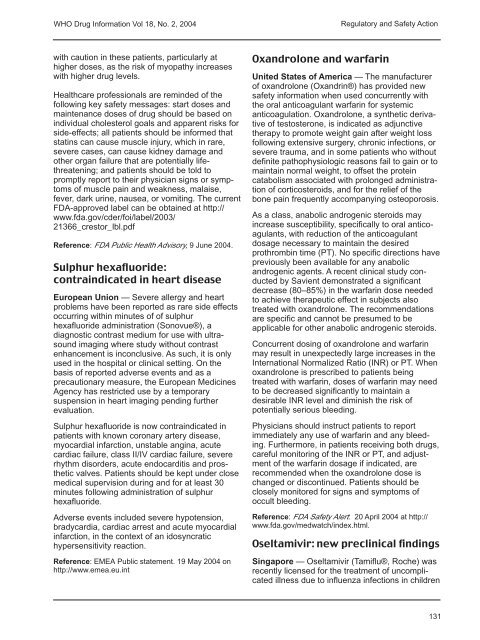WHO Drug Information Vol. 18, No. 2, 2004 - World Health ...
WHO Drug Information Vol. 18, No. 2, 2004 - World Health ...
WHO Drug Information Vol. 18, No. 2, 2004 - World Health ...
Create successful ePaper yourself
Turn your PDF publications into a flip-book with our unique Google optimized e-Paper software.
<strong>WHO</strong> <strong>Drug</strong> <strong>Information</strong> <strong>Vol</strong> <strong>18</strong>, <strong>No</strong>. 2, <strong>2004</strong><br />
with caution in these patients, particularly at<br />
higher doses, as the risk of myopathy increases<br />
with higher drug levels.<br />
<strong>Health</strong>care professionals are reminded of the<br />
following key safety messages: start doses and<br />
maintenance doses of drug should be based on<br />
individual cholesterol goals and apparent risks for<br />
side-effects; all patients should be informed that<br />
statins can cause muscle injury, which in rare,<br />
severe cases, can cause kidney damage and<br />
other organ failure that are potentially lifethreatening;<br />
and patients should be told to<br />
promptly report to their physician signs or symptoms<br />
of muscle pain and weakness, malaise,<br />
fever, dark urine, nausea, or vomiting. The current<br />
FDA-approved label can be obtained at http://<br />
www.fda.gov/cder/foi/label/2003/<br />
21366_crestor_lbl.pdf<br />
Reference: FDA Public <strong>Health</strong> Advisory, 9 June <strong>2004</strong>.<br />
Sulphur hexafluoride:<br />
contraindicated in heart disease<br />
European Union — Severe allergy and heart<br />
problems have been reported as rare side effects<br />
occurring within minutes of of sulphur<br />
hexafluoride administration (Sonovue®), a<br />
diagnostic contrast medium for use with ultrasound<br />
imaging where study without contrast<br />
enhancement is inconclusive. As such, it is only<br />
used in the hospital or clinical setting. On the<br />
basis of reported adverse events and as a<br />
precautionary measure, the European Medicines<br />
Agency has restricted use by a temporary<br />
suspension in heart imaging pending further<br />
evaluation.<br />
Sulphur hexafluoride is now contraindicated in<br />
patients with known coronary artery disease,<br />
myocardial infarction, unstable angina, acute<br />
cardiac failure, class II/IV cardiac failure, severe<br />
rhythm disorders, acute endocarditis and prosthetic<br />
valves. Patients should be kept under close<br />
medical supervision during and for at least 30<br />
minutes following administration of sulphur<br />
hexafluoride.<br />
Adverse events included severe hypotension,<br />
bradycardia, cardiac arrest and acute myocardial<br />
infarction, in the context of an idosyncratic<br />
hypersensitivity reaction.<br />
Reference: EMEA Public statement. 19 May <strong>2004</strong> on<br />
http://www.emea.eu.int<br />
Oxandrolone and warfarin<br />
Regulatory and Safety Action<br />
United States of America — The manufacturer<br />
of oxandrolone (Oxandrin®) has provided new<br />
safety information when used concurrently with<br />
the oral anticoagulant warfarin for systemic<br />
anticoagulation. Oxandrolone, a synthetic derivative<br />
of testosterone, is indicated as adjunctive<br />
therapy to promote weight gain after weight loss<br />
following extensive surgery, chronic infections, or<br />
severe trauma, and in some patients who without<br />
definite pathophysiologic reasons fail to gain or to<br />
maintain normal weight, to offset the protein<br />
catabolism associated with prolonged administration<br />
of corticosteroids, and for the relief of the<br />
bone pain frequently accompanying osteoporosis.<br />
As a class, anabolic androgenic steroids may<br />
increase susceptibility, specifically to oral anticoagulants,<br />
with reduction of the anticoagulant<br />
dosage necessary to maintain the desired<br />
prothrombin time (PT). <strong>No</strong> specific directions have<br />
previously been available for any anabolic<br />
androgenic agents. A recent clinical study conducted<br />
by Savient demonstrated a significant<br />
decrease (80–85%) in the warfarin dose needed<br />
to achieve therapeutic effect in subjects also<br />
treated with oxandrolone. The recommendations<br />
are specific and cannot be presumed to be<br />
applicable for other anabolic androgenic steroids.<br />
Concurrent dosing of oxandrolone and warfarin<br />
may result in unexpectedly large increases in the<br />
International <strong>No</strong>rmalized Ratio (INR) or PT. When<br />
oxandrolone is prescribed to patients being<br />
treated with warfarin, doses of warfarin may need<br />
to be decreased significantly to maintain a<br />
desirable INR level and diminish the risk of<br />
potentially serious bleeding.<br />
Physicians should instruct patients to report<br />
immediately any use of warfarin and any bleeding.<br />
Furthermore, in patients receiving both drugs,<br />
careful monitoring of the INR or PT, and adjustment<br />
of the warfarin dosage if indicated, are<br />
recommended when the oxandrolone dose is<br />
changed or discontinued. Patients should be<br />
closely monitored for signs and symptoms of<br />
occult bleeding.<br />
Reference: FDA Safety Alert: 20 April <strong>2004</strong> at http://<br />
www.fda.gov/medwatch/index.html.<br />
Oseltamivir: new preclinical findings<br />
Singapore — Oseltamivir (Tamiflu®, Roche) was<br />
recently licensed for the treatment of uncomplicated<br />
illness due to influenza infections in children<br />
131

















